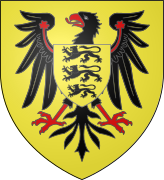Gold (heraldry)
In heraldry, gold is the denomination of one of the two metals used in the representation of armories; the other is silver or argen. It represents the homonymous metal.
Representation
Conventionally it is represented by the colors gold, gold and yellow. Sometimes it is recommended, for this purpose, to use a yellow mixed with some ocher color so that it has a warm tint, but always keeping in mind that the final color it should not be so reddish that it can be confused with orange enamel.
Sometimes the artist may use gold paint or a gold metal to represent heraldic gold; these practices are usually seen in coats of arms that have been worked with an ornamental or especially artistic intention.
When colors are not available, gold is represented by a pattern of dots alternated equidistant from the next line, according to the method attributed to the Jesuit Silvestre Pietra Santa. This is the representation method commonly seen in engravings an ink.
Examples of use
Three notable ancient examples of the use of gold in heraldry follow.
From the arms of Frederick I Barbarossa would derive the Coat of Arms of the Holy Roman Empire and, through this, the current coat of arms of Germany.
Names, attributions and meanings in disuse
Towards the beginning of the Renaissance, a system of symbolic correspondences for heraldic colors was developed that is now in disuse. It is noteworthy that around 1828 this system was considered absurd by the English heraldist William Berry, although the Spanish Francisco Piferrer, in 1858, comments on it as if it were still valid.
Although Jean Courtois, Sicilian Herald of the Kingdom of Aragon, mentions in his treatise Le blason des couleurs (1414) that any of these heraldic gold associations can be used to emblazon, in practice it is possible that only the planetary system and the gemstone system were used. For Alberto and Arturo García Caraffa (1919), emblazoned with gems corresponded to titles and planets to sovereigns. Arthur Fox-Davies cites an example of emblazoned with precious stones dating from 1458.
Below are some of the ancient symbolic correspondences of heraldic gold, as well as some of the "Greek" names attached to it.
| Names "Greeks" | citrine, cricasy, emryagi |
| Metal | the gold |
| Planet | The Sun |
| Beautiful stone | the topaz, the carbunclo |
| Zodiac Sign | Leo |
| Element | the air, the fire |
| Station of the year | spring |
| Month | July |
| Weekday | Sunday |
| Numbers | 1, 3, 2, 7 |
| Tree | the cypress |
| Flower | the calendula, the sunflower, the keyword of Indias, the mother |
| Ave | the rooster, the gold, |
| Cuadrupe | The lion |
| «Pez» | the dolphin |
| Age of man | adolescence, youth |
| Human complexion | blood |
| Theological and cardinal virtues | faith, justice, charity |
| Virtues and worldly qualities | constancy, nobility, wealth, solidity, purity, gravity, love, power, joy, long life and eternity, holiness, patience, wisdom, divine glory, splendour, gentleness, strength, perfection, fidelity, cavalry, generosity, sovereignty, health, prosperity, mercy |
| Obligations of the carrier | doing good to the poor and defending their homeland |
In addition, gold would be "the noblest" of heraldic colors.
Contenido relacionado
King Kong (1933 film)
Dante Quinterno
Witness for the prosecution (film)




